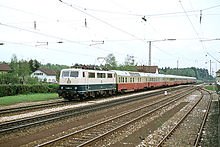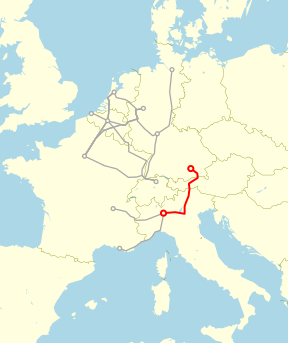Mediolanum (train)
| Mediolanum | |
|---|---|
| Train type: | |
| Countries: |
|
| First drive: | October 15, 1957 |
| Former operator: | Ferrovie dello Stato / Deutsche Bundesbahn / Swiss Federal Railways / Cisalpino |
| route | |
| Departure station: | Milano Centrale |
| Destination station: | Munich Hbf / Basel SBB |
| Railway line: | Brenner / Gotthard |
| Technical specifications | |
| Rolling stock: | ALn 442-448 VT 11.5 FS TEE Gran Conforto FS E.656 DB 111 ÖBB 1044 |
| Gauge (s) : | 1435 mm |
| Power system (s): | 3000 V DC / 15 kV 16.7 Hz |
| Train run | |
Mediolanum is the name of a Trans-Europ-Express (TEE), which operated between Munich and Milan from 1957 to 1984 and which was supposed to replace the airplane in the first years of its existence due to the low number of flight movements between the two cities. It was part of the Europe-wide TEE network from the start and always traveled the same route. "Mediolanum" is the Latin name of the city of Milan.
history
The first TEE Mediolanum started on October 15, 1957 from Milan via Verona , Trient , Bozen , Brenner , Innsbruck and Kufstein to Munich, initially under the train number TEE 395/396. In Austria , whose railway ÖBB had not yet joined the TEE agreement at that time, the TEE was operated as a TS train type (multiple unit express train) and viewed as transit traffic.
At the beginning, the train took seven hours and 20 minutes to travel between the two endpoints, and in the opposite direction even 14 minutes longer. The intermediate stops alone took 31 minutes, and the border stop at the Brenner lasted a quarter of an hour. An hour and 27 minutes were planned for the distance to be covered in Austria (including a two-minute stay in Innsbruck). In Milan the start was between six and seven o'clock in the morning, in Munich always at 4:00 pm.
From 1958 to 1968 Rovereto was also served. The train number changed to 393/395. Another change in the train number took place between 1960 and 1964, when the Mediolanum ran jointly between Milan and Verona with a part of the train going to and from Venice . In Italy, the train number was now MV and VM in the opposite direction, in line with local customs. When the train routes were separated again after 1967, the Mediolanum operated as TEE 17/18. From 1971 the train number was changed to TEE 84/85 at the start of the summer timetable. The TEE drove under this until its end in May 1984.
Train and wagon use
At the beginning, newly developed double diesel multiple units of the Italian state railway FS of the series Aln 442/448 were used in the train route of the Mediolanum , from 1960 to 1964 between Milan and Verona coupled with the electric multiple unit ALe 601 to Venice . The criticism of the Italian set increased over time, as it had neither air conditioning nor a dining compartment, only offered seat service, the mechanical diesel drive was relatively loud and the seating capacity was not always sufficient. In the 1960s , the International Timetable Conference rejected an application by the Deutsche Bundesbahn (DB) to combine the inner-German F-train Blauer Enzian (Hamburg - Munich) with the Mediolanum to form a train route.

It was not until 1969 that the TEE railcars of the German class 601 were used in the train run. Schedule was such a set of only three because of the difficult Brenner route Abteil- , a dining and a saloon car between the two power cars . If necessary, a sixth car could be added. When going downhill there were problems with hot brake discs. However, travel times in both directions could be reduced by almost an hour. This mission lasted only three years.

On August 20, 1972, the train was switched to the newly built 26.4 meter long TEE wagons of the FS (FS TEE Gran Conforto). The series consisted of the Az compartment car , the Apz open seating car, a WRz dining car operated by the International Sleeping Car Company (ISG), and a combined generator / luggage car Dz to power the train. A 110.3 , "crease", was mostly used on the Munich - Brenner route. From 1974 a new class 111 locomotive was hooked in front of the train. From 1982 to the end of 1984 Austrian electric locomotives of the 1044 series took over the train, on the Italian side electric locomotives of the E.444 series , later E.656 . The TEE wagons of the FS were converted after the end of the TEE traffic and used in domestic traffic.
accident
The chronicle of the TEE Mediolanum records a major accident on March 28, 1964, when the train in Kufstein collided head-on with an electric locomotive of the ÖBB class 1010.1 .
Diversions
In the event of diversions, the Mediolanum could run via the Mittenwaldbahn Innsbruck - Garmisch-Partenkirchen - Munich or, in the case of closures on the Brenner, also via the Gotthardbahn and Zurich - Lindau .
InterCity / EuroCity
With the beginning of the summer timetable in 1984, the Mediolanum was replaced by the InterCity Nymphenburg , which was extended from Munich to Milan and changed its name to Mediolanum . The train was replaced by a EuroCity, which operated as the EC 88/89 Leonardo da Vinci between Munich and Milan until 2011 . There were also three more EC trains, two pairs of trains between Munich and Verona as Garda (EC 80/81) and Paganini (EC 82/83), the EC 86/87 Tiepolo Munich – Venice and the EC 84/85 with the old Mediolanum Train number, Michelangelo , Munich – Rome.
From 2009, the individual Zugnamen fell off the trains were now on under the common name DB-ÖBB EUR City with rolling stock of ÖBB out. The new terminus of the EC 88/89 was Milano Porta Garibaldi . Since 2011 there has not been a free connection between Munich and Milan, the EC 80 to 89 run from Munich to Verona, with a connection to a Frecciarossa or Frecciabianca to Milan, and sometimes further to Venice, Bologna and Rimini (and back).
Gotthard Railway Mediolanum
The train name received a renaissance in the early 2000s, but on the Gotthard Railway as an InterCity train route Basel SBB - Lucerne - Milano Centrale. While only the "normal" IC stops such as Arth-Goldau, Bellinzona, Lugano, Chiasso or Como SG were served on the outward journey to Milan , the train also stopped at stations such as Faido, Airolo, Göschenen, on the evening return journey to Switzerland. Erstfeld, Schwyz or Rotkreuz . In 2004 the stop in Schwyz was given up, instead the train stopped in Flüelen . In 2005 the SBB and Trenitalia handed over the operation of the IC Mediolanum to Cisalpino AG , from now on the train figured as the EC Cisalpino Mediolanum .
In 2008 the train was replaced by a nameless Cisalpino and to Zurich HB, the train stops between Bellinzona and Arth-Goldau, as well as the Arth-Goldau – Basel SBB line were replaced by a parallel InterRegio . After the dissolution of Cisalpino AG, this train runs again as EuroCity, but with no name.
literature
- Center for public relations UIC: TEE . Ed .: Union Internationale des Chemins de Fer. Paris 1972 (Dutch).
- Jörg Hajt: The big TEE book . Ed .: Heel. Bonn / Königswinter 2001, ISBN 3-89365-948-X .
- Torsten Berndt: Travel 1st class VT 11.5 . Ed .: Märklin. Irsee 2002.
- Franco Dell'Amico: Il TEE Breda . Ed .: ACME. Savona 2005 (Italian).
- Maurice Mertens and Jean-Pierre Malaspina: La Légende des Trans Europ Express . Ed .: LR press. Vannes 2007, ISBN 978-2-903651-45-9 (French).
- Peter Goette: TEE trains in Germany . Ed .: EK Verlag. Freiburg 2008, ISBN 978-3-88255-698-8 .
Individual evidence
- ↑ a b Next summer: Super train Vienna – Zurich. The "Mediolanum" - airplane on wheels . In: Arbeiter-Zeitung . Vienna October 19, 1957, p. 6 , bottom right ( berufer-zeitung.at - the open online archive - digitized).
- ↑ TEE , page 24
- ^ Il TEE Breda , pages 46-47
- ^ Il TEE Breda , page 51
- ^ Il TEE Breda , page 48
- ↑ TEE trains in Germany , page 95
- ↑ La légende des TEE , page 206
- ↑ TEE trains in Germany , page 94
- ↑ TEE trains in Germany , page 95
- ↑ La légende des TEE , page 208
- ^ Traveling 1st class , page 89
- ↑ TEE trains in Germany , page 95
- ^ Traveling 1st class , page 86
- ^ La légende des TEE , page 134
- ^ La légende des TEE , page 139
- ↑ The Great TEE Book , page 118
- ↑ Il TEE Breda , page 13
- ↑ TEE trains in Germany , page 98
- ↑ La légende des TEE , page 209


